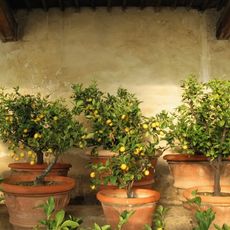Golden Midget Watermelon Plant Info

Besides apple pie and the bald eagle, there is nothing quite as fundamentally American as the watermelon. For our household of two, a full size watermelon is a bit more than we can handle. Luckily, there are many personal sized watermelon varieties available and amongst these is the Golden Midget watermelon plant. Before we delve into Golden Midget watermelon growing, let's look into this heirloom's history.
Heirloom Watermelon History
Although watermelons are a staple of the American palate, the watermelon actually hails from Southwest Africa, cultivated for its ability to absorb and retain lots of water, and thereby, making it an important source of uncontaminated water, which is a vital resource in that region. In the States, however, we have reliable, safe water. We just love the sweet, juicy flavor of watermelons! Eventually, watermelon cultivation made its way to the Middle East, into southern Europe and finally to the southern United States. Lucky us! Of course, the northerners wanted to grow this succulent fruit as well, so shorter season varieties were bred or brought over from Russia. One of these short season varieties is our melon under discussion, the Golden Midget. The Golden Midget was developed by Elwyn Meader and Alber Yeager at the University of New Hampshire after a mind-boggling 10 years of work. Bet that was fun. This particular long-developed heirloom is a cross between the New Hampshire Midget and Pumpkin Rind.
Golden Midget Watermelon Growing
The Golden Midget not only has a short growing season, but the color of the maturing fruit is a great indicator for ripeness. No more guess work on when exactly to pick the melon at its peak, as this variety obligingly turns a golden yellow when it is ripe. So I guess you figured out by now where the name comes from, huh? As mentioned, this is a smaller watermelon, what is referred to as a "personal" size, although at about 3 pounds, there is still plenty of melon to savor and share with a couple other people! Like all watermelons, the Golden Midget (Citrullus lanatus) thrives in full sun and needs consistent moisture. Unless you live in a very warm climate, this little beauty should be started indoors 4 weeks before the last frost for your area; sow seeds ¼ - ½ inch deep. Transplant outdoors once the soil has warmed. Remember, watermelons are heat lovers, so be sure the soil is warm since cool soil will kill off your seedlings. If you are starting outdoors, sow 6-8 seeds in a hill ½ inch deep, then thin to 3-4 plants per hill. And that's all there is to it! Within about 70 days, the fruits of your labor will be ready to sink your teeth into. But don't take my word for it, the Golden Midget will kindly herald its readiness to be picked by turning from green to yellow on the outside with the promise of sweet, juicy bright pink flesh inside. I'm salivating already. Oh, one final comment. Some people say this varietal has a lot of seeds. To me, seeds are to be expected in a melon, but in this case, they grow in channels and are easily scooped out if they bother you. For myself, I think melon seeds are just an excuse to indulge in a good old-fashioned spitting contest just like we did when we were kids!
Gardening tips, videos, info and more delivered right to your inbox!
Sign up for the Gardening Know How newsletter today and receive a free download of our most popular eBook "How to Grow Delicious Tomatoes."

Amy Grant has been gardening for 30 years and writing for 15. A professional chef and caterer, Amy's area of expertise is culinary gardening.
-
 How To Grow Garden To Table: A Guide For Home Cooks
How To Grow Garden To Table: A Guide For Home CooksWhat could be better than a meal that comes directly from garden to table? Show off your gardening and culinary skills with the very freshest food.
By Bonnie L. Grant
-
 Want a Backyard Mini Orchard? Create Your Own Container Orchard
Want a Backyard Mini Orchard? Create Your Own Container OrchardEasier to care for in small spaces, a backyard mini-orchard makes sense for busy gardeners and juicy fruit is the reward.
By Teo Spengler